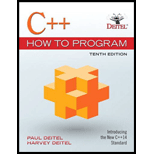
C++ How to Program (10th Edition)
10th Edition
ISBN: 9780134448237
Author: Paul J. Deitel, Harvey Deitel
Publisher: PEARSON
expand_more
expand_more
format_list_bulleted
Textbook Question
Chapter 7, Problem 7.23E
(Knight's Tour: Brute Forty Approaches ) In Exercise 7.22, we developed a solution to the Knight's Tour problem. The approach used, called the "'accessibility heuristic," generates many solutions and executes efficiently.
As computers continue increasing in power, we'll be able to solve more problems with sheer computer power and relatively unsophisticated algorithms. This is the "brute force" approach to problem solving.
- Use random number generation to enable the knight to walk around the chessboard (in its legitimate L—shaped moves, of course) at random, Your
program should run one tour and print the final chessboard. How far did the knight get? - Most likely, the preceding program produced a relatively short tour. Now modify your program to attempt 1000 tours. Use a one-dimensional array to keep track of the number of tours of each length. When your program finishes attempting the 1000 tours, it should print this information in near tabular format. What was the best result?
- Most likely, the preceding program gave you some "respectable" tours, but no full tours. NOW "pull all the stops out" and simply let your program run until it produces a full Tour. [Caution. This version of the program could run for hours on a powerful computer. ] Once again, keep a table of the number of tours of each length, and print this when the first full tour is found. How many tours did your program attempt before producing a full tour? How much time did it take?
- Compare the brute force version Of the Knight's Tour with the accessibility heuristic version. Which required a more careful study of the problem? Which
algorithm was more difficult to develop? Which required more computer power? Could we be certain (in advance) of obtaining a full tour with the accessibility heuristic approach? Could we be certain (in advance) of obtaining a full tour with the brute force approach? Argue the pros and cons of brute-force problem-solving in general.
Expert Solution & Answer
Want to see the full answer?
Check out a sample textbook solution
Students have asked these similar questions
Design and draw a high-level "as-is" process diagram that illustrates a current process related to a product or service offered through the SSDCI.gov database.
Compare last-mile connections for connecting homes and businesses to the Internet
Explain wireless networking standards
Chapter 7 Solutions
C++ How to Program (10th Edition)
Ch. 7 - Exercises 7.6(Fill in the Blanks) Fill in the...Ch. 7 - (True or False) Determine whether each of the...Ch. 7 - (Write C++ Statements) Write C++ statements to...Ch. 7 - (Two-Dimensional array Questions) Consider a...Ch. 7 - (Salesperson Salary Ranges) Use a one-dimensional...Ch. 7 - (One-Dimensional array Questions) Write statements...Ch. 7 - (Find the Errors) Find the error(s) in each of the...Ch. 7 - (Duplicate Elimination with array) Use a...Ch. 7 - Prob. 7.14ECh. 7 - Prob. 7.15E
Ch. 7 - (Dice Rolling) Write a program that simulates...Ch. 7 - ( What Does This Code Do?) What does the following...Ch. 7 - (Craps Game Modification) Modify the program of...Ch. 7 - (Converting vector Example of Section 7.10 to...Ch. 7 - Prob. 7.20ECh. 7 - (Sales Summary) Use a two-dimensional array to...Ch. 7 - (Knight's Tour) One of the more interesting...Ch. 7 - (Knight's Tour: Brute Forty Approaches ) In...Ch. 7 - (Eight Queens) Another puzzler for chess buffs is...Ch. 7 - (Eight Queens: Brute Force Approaches) In this...Ch. 7 - Prob. 7.26ECh. 7 - (The Sieve of Eratosthenes) A prime integer is any...Ch. 7 - Prob. 7.28RECh. 7 - (Eight Queens) Modify the Eight Queens program you...Ch. 7 - (Print an array) Write a recursive function...Ch. 7 - Prob. 7.31RECh. 7 - Prob. 7.32RECh. 7 - (Maze Traversal) The grid of hashes (#) and dots...Ch. 7 - Prob. 7.34RECh. 7 - Making a Difference 7.35 (Polling) The Internet...
Knowledge Booster
Learn more about
Need a deep-dive on the concept behind this application? Look no further. Learn more about this topic, computer-science and related others by exploring similar questions and additional content below.Similar questions
arrow_back_ios
SEE MORE QUESTIONS
arrow_forward_ios
Recommended textbooks for you
 C++ Programming: From Problem Analysis to Program...Computer ScienceISBN:9781337102087Author:D. S. MalikPublisher:Cengage Learning
C++ Programming: From Problem Analysis to Program...Computer ScienceISBN:9781337102087Author:D. S. MalikPublisher:Cengage Learning C++ for Engineers and ScientistsComputer ScienceISBN:9781133187844Author:Bronson, Gary J.Publisher:Course Technology Ptr
C++ for Engineers and ScientistsComputer ScienceISBN:9781133187844Author:Bronson, Gary J.Publisher:Course Technology Ptr Operations Research : Applications and AlgorithmsComputer ScienceISBN:9780534380588Author:Wayne L. WinstonPublisher:Brooks Cole
Operations Research : Applications and AlgorithmsComputer ScienceISBN:9780534380588Author:Wayne L. WinstonPublisher:Brooks Cole- Programming Logic & Design ComprehensiveComputer ScienceISBN:9781337669405Author:FARRELLPublisher:Cengage
 EBK JAVA PROGRAMMINGComputer ScienceISBN:9781337671385Author:FARRELLPublisher:CENGAGE LEARNING - CONSIGNMENT
EBK JAVA PROGRAMMINGComputer ScienceISBN:9781337671385Author:FARRELLPublisher:CENGAGE LEARNING - CONSIGNMENT

C++ Programming: From Problem Analysis to Program...
Computer Science
ISBN:9781337102087
Author:D. S. Malik
Publisher:Cengage Learning

C++ for Engineers and Scientists
Computer Science
ISBN:9781133187844
Author:Bronson, Gary J.
Publisher:Course Technology Ptr

Operations Research : Applications and Algorithms
Computer Science
ISBN:9780534380588
Author:Wayne L. Winston
Publisher:Brooks Cole

Programming Logic & Design Comprehensive
Computer Science
ISBN:9781337669405
Author:FARRELL
Publisher:Cengage

EBK JAVA PROGRAMMING
Computer Science
ISBN:9781337671385
Author:FARRELL
Publisher:CENGAGE LEARNING - CONSIGNMENT
C++ Programming Tutorial 36 - Intro to Loops; Author: Caleb Curry;https://www.youtube.com/watch?v=M3o7Y0juEP0;License: Standard YouTube License, CC-BY